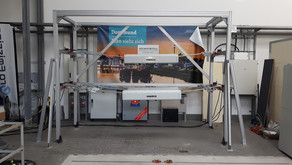System theoretical analysis of voltage stability in power electronic dominated hybrid power systems (DFG)

In the past decades, static voltage stability was described primarily through the analysis of the load flow Jacobian matrix of its electric network. Dynamic voltage stability was described as the mutual interaction of voltage control of conventional synchronous generators (SGs) at transmission grid level, on-load tap changers (OLTCs) and dynamic load models including induction motors at distribution grid level. The knowledge about the nonlinear mechanisms of voltage (in)-stability was obtained by system theoretical analyses focusing on the interaction of these components. However, power systems are becoming much more complex and controllable due to the increase of power electronic (PE) components like decentralised energy resources (DER), PE-interfaced loads, high-voltage direct current (HVDC) links, flexible AC transmission systems (FACTS) and multi-modal interfaces to the gas or heat system, which influence these stability mechanisms fundamentally. The new challenge for analysing voltage stability is that these devices have autonomous controllers that can discretely change their dynamics, e.g. for low voltage fault ride-through (FRT), current limiting, change from a grid-forming to a grid-following mode or switch to another voltage control strategy. Based on this, PE-based devices cannot only be described by continuous states, but also by discrete states for their control. Therefore, they can be modelled as hybrid systems (a mathematical model that consists of continuous and discrete states see). Alongside the conventional methods, the hybrid system approach enables new modelling and stability analysis methods from control theory and computer science like hybrid automata and reachability analysis. This can lead to new insights in the mechanisms of voltage stability that might otherwise be difficult to find. In general, the challenge for ensuring voltage stability lies in extending the knowledge about novel stability mechanisms before a (partial) blackout occurs in a significantly changed energy power system. Moreover, the gained knowledge helps to derive design criteria and countermeasures to guarantee secure system operation in future PE-dominated power systems.
Through the integration of PE-based devices in the power grid, new mechanisms of voltage (in)-stability can arise at all voltage levels. At transmission level, a likely solution to counterattack the decommissioning of conventional power plants is to implement grid-forming controls in HVDC converters to emulate the inherent characteristics of SGs for providing dynamic stability. However, these characteristics are greatly lost when reaching their maximum current, resulting from a grid-forming into a grid-following mode. For this reason, this switch in control can considerably change the mechanisms of voltage instability due to the loss in power balancing. At distribution level, the rapid increase of fast restoring PE-loads and DERs can lead to undesired low voltages due to voltage insensitivity and current limited flexibility. Also, undesired voltage oscillations between voltage regulating DERs and PE-loads are possible which could be evoked by their fast controllability. In addition, due to the increased number of controlling entities, interactions between DERs and OLTCs could occur in case of inadequate parameterisation or opposite reference values. Cross-voltage level phenomena can occur if superordinate distribution grid controls, that provide ancillary services to the transmission system, are not coordinated properly resulting in oscillations or contrary reactive power flows.
Summarizing the above stated problem: The ongoing transformation of the energy system leads to a steadily increasing share of PE-devices both on generation as well as on load side, which could arise new nonlinear mechanisms of voltage (in)-stability at transmission and distribution level. This project aims at analysing and describing these mechanisms on a system theoretical level to reveal the basic impact principle behind the new drivers of voltage instability and revise known voltage stability mechanisms. For this purpose, the hybrid system approach is chosen to take into account the switching dynamics of PE-devices and thus extending the conventional modelling and stability assessment methods.
- Project duration: 01/2022- 12/2024
- Funded by the German Research Foundation (DFG) within the Priority Program 1984: Hybrid and Multimodal Energy Systems: System Theoretical Methods for the Transformation and Operation of Complex Networks
Sponsors






